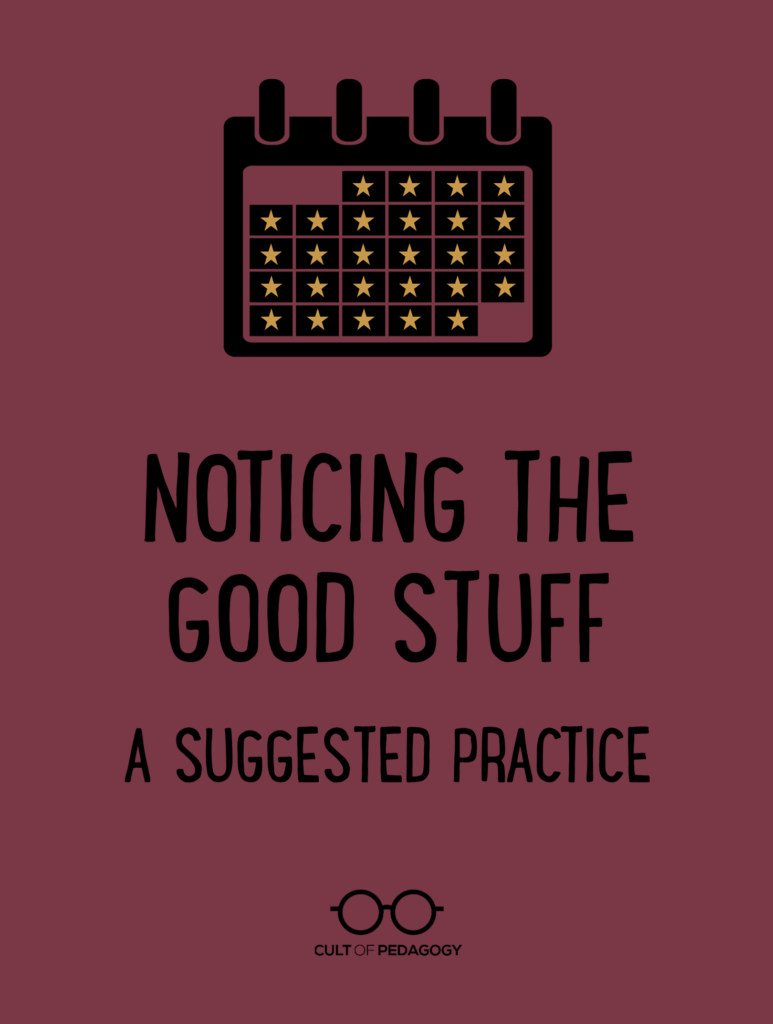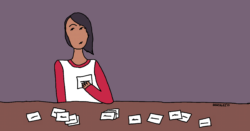
When something amazing happens in your classroom but only you see it, did it really happen? Sometimes I feel that way. There’s a moment: a quiet, kind interaction between two students who often bicker, or a new game that students manage to play well without a hitch, or when you suddenly remember a long-forgotten idea which is perfect for helping the student in front of you. These things happen and may even catch us by surprise. But then what do we do with those moments?
In the rush of day-to-day teaching, I’m afraid that many of those moments may get lost. Or perhaps more likely, they get buried. So much happens in a school day, there are literally thousands of discrete interactions and decisions made, the majority of which are in connection with other people. And our brains are wired to hold onto negative information to prevent mistakes in the future. So when good or even great things happen in our classrooms or during the school day, they may not be top of mind once class is over. They are more likely somewhere in the middle, sandwiched between the heated parent e-mail in the morning and the unanticipated extra recess duty in the afternoon. For those of us who teach in environments where good news may not be met with enthusiasm, mentioning and retaining those bright spots becomes another challenge. Lacking an outlet or container for these episodes can also make it difficult for us to connect them with other positive moments we’ve had.
As educators we’re aware of the benefits of positive reinforcement and the need for confidence-building in our pedagogy for students. But that’s often where it stops. When it comes to our own learning and day-to-day practice, how regularly do we apply a similar reasoning? How actively do we acknowledge our wins as fully as our setbacks? In this post I want to advocate for seeking out the good in our own gardens and cultivating our best with what we have right now, even as we are bombarded with stories of greener grass everywhere we look.
Working on What Works
These ideas have not emerged out of the ether. My thinking about this approach stems from a program for the classroom, based on Solution-focused Brief Therapy, called Working on What Works (WOWW) developed by Insoo Kim Berg and Lee Shilts. In a nutshell, the program calls on students and teachers to notice and articulate specific actions that contribute to the success of an intervention. Students learn to observe, name and compliment the behaviors that have been identified as positive and nurturing.
Two factors come together in this approach which turn out to be especially effective in building classroom confidence and community: First is a focus on strengths—in individual student behaviors, in the class group, in the observable results. The second piece is an emphasis on student input and feedback on their own progress individually and as a group. Taken together, while Working on What Works, students and teachers learn to keep their eyes and ears open for the good stuff: compliments, celebrations, breakthroughs, perseverance and how to share that news with each other. This video provides an example of the program in practice.
Noticing the Good for Ourselves
I think there are lots of avenues we can travel in locating our very distinct examples of teaching/learning goodness. The suggestions here serve as a sort of starter pack for collecting your own shining moments and to train your eyes to see more of the bright spots. Some of these can be done on your own, yet many might be fun and enlightening to try with a friend or colleague.
Observing and listening:
- Describe a winning moment/event you observed in someone else’s classroom.
- Describe a winning moment/event in your own classroom.
- Be on the lookout for bright spots in your learning community. Consider documenting them in a journal or through other means.
- When dealing with a student behavior you find difficult, later consider asking: What have you seen the student do well? When is the student most likely to set the difficult behaviors aside?
- When something makes you laugh out loud when you are with students, write it down afterwards. What was it? What was the source of the humor?
- When a student gives you a compliment, listen carefully. Which compliments do you hear from students most often? What do your students love about you?
- When parents express gratitude, listen carefully. What are parents grateful for? How have you served them and their children?
- When colleagues ask for your advice or input, think about what allows them to trust and value your contribution.
Reading and writing ideas:
- When you examine student work, notice evidence of growth. List all the things, large and small, that you accomplished, helped along, kept in check, turned around, made happen in the process. Capture those reflections in a journal entry, blog post, on the back of an envelope or share with a teammate.
- Write a thank-you note to yourself. (No really, hear me out.) This may sound goofy and feel very awkward but please try it. Sit down and scratch out a few sentences telling yourself what you’ve accomplished, improved, learned. Don’t edit, just write, read and put it in a place where you can stumble upon it later.
- If you enjoy engaging on social media, try finding a few fellow educators who blog about their classroom experiences where student strengths feature prominently. Leave comments to show appreciation or connect it to your own practice. Two edubloggers I find who do this especially well are Julia Torres and Jennifer Orr.
- Particularly if you are looking for a community of teacher bloggers to share wins and practice various modes of writing at the same time, you might consider joining the Slice of Life Community, sponsored by the Two Writing Teachers. Teachers post on Tuesdays and commit to commenting on at least 3 blogs per week. I have enjoyed this new outlet for sharing brief reflections and receiving encouragement along the way.
Making it stick
Highlighting and keeping track of the wins in our own intimate teaching spaces and inside our filled-to-the-brim heads should not become a new chore. Instead, find a method of collecting and/or sharing these moments that feels right for you and the way you work. Here are a few suggestions:
To do on your own:
- Where do you keep your lesson plans or planning notes? Create a dedicated space or use sticky notes. Try recording one good thing per day for a number of days in a row 10, 15, 30—whatever feels manageable. At the end of each week, review them and see if any patterns emerge.
- In any parent correspondence such as newsletters, portfolio updates or class blog, note specific evidence of teaching and learning successes. Reflect on progress made and take a moment to acknowledge what you did or are doing to enable those instances of growth in your classroom.
- Keep a micro journal on your desk to jot down 1-2 bright spots per class (or perhaps create a electronic file to do the same).
To do with colleagues:
- Create a shout-out board where teachers can leave notes describing winning moments observed among staff.
- Tweet, blog, pin or post a winning moment on your social media outlet of choice. Consider starting a hashtag to encourage others to join you. #Eduwins, perhaps. Or #WOWWmoment.
- Find a group of colleagues and agree on a time to have lunch or other break time together. Dedicate the first few minutes to sharing success stories with each other. This could also be applied at any regular meeting fixture.
While I have not yet been in a position to pursue the full WoWW program, the thinking behind it remains a central part of my teaching practice: emphasizing and bolstering strengths. That’s why I feel it is doubly important that we practice these ideas on ourselves first before showering our students with so much new-found wisdom. Whenever we take an opportunity to reflect on and document our wins in the classroom, it adds to our self-efficacy and builds our confidence as teachers. We fertilize our own growth as educators and cultivate gardens of learning and community with our students. ♦
Join our mailing list and get weekly tips, tools, and inspiration that will make your teaching more effective and fun. You’ll get access to our members-only library of free downloads, including 20 Ways to Cut Your Grading Time in Half, the e-booklet that has helped thousands of teachers save time on grading. Over 50,000 teachers have already joined—come on in!





What encouraging and thoughtful advice. My very first year of teaching, which happened in a volunteer setting overseas 25+ years ago, I kept a tiny diary of my teachings ups and downs. I think it was a good instinct, and I plan to return to it using your thoughts! Thank you!
Wendy, this is a great idea as well. Keeping track of things that occur throughout a year is important so we can reflect on what went well. Having constant reminders that things are good helps morale, and if shared on a regular basis with students, can create that moral boost that all students need throughout a given school year.
Hi, this is really intriguing. The “Working on What Works” link requires creation of an account and apparently a long approval process for access. Is there any other official source for information on this program?
Hi Joy! I work for Cult of Pedagogy. The link should open to a page from researchgate.net that has a PDF available for download all about WOWW. There is a little screen that comes up asking if you’d like to join, but you can just click on the X on the box to close it out. Hope this helps!
Thank you! It seems that ResearchGate blocked me because I tried to open the link on my school’s network and RG detected ‘unusual traffic’ on our server. I was able to access it from home. 🙂
I needed this right now. I have been struggling this year with new admin, and tough kids, and trying a new format of grading using proficiency-based grading. I need to try to focus on the positives in classes.
Thank you for these wonderful suggestions. These explicit, easy ideas will certainly be implemented in my room this year to help stay focused on the beautiful, positive moments of teaching.
So glad you enjoyed the post!
Thank you! This is really helpful. Those great ideas will help me to design my new school year class more efficiently.
Jenn will be happy to hear you found it helpful!
I love Working on What Works (WOWW) !! What an amazing idea to “keep track of the wins”.
Thank you for these suggestions. As a new teacher this is really helpful.
I loved this article! I really liked the concept of teachers focusing on the positive things that happen, and finding a way to remember them. When I was reading I started thinking about a book I read recently called, “Social Emotional Learning and the Brain” by Marilee Sprenger. The book has a chapter about empathy with a bunch of great strategies to help students learn empathy to become more kind and positive to their peers. Some great ideas included notes of appreciation that you can write to students or that you can encourage them to write. Another great strategy is having a kindness wall, where students record positive experiences they see in school that they then write down and put up on the wall. It is so important that as teachers we remain positive, but helping students do the same thing can create a beautiful culture.
Thanks so much for sharing this, Lauren!
This post is an excellent reminder that all successes, both big and small, in our classrooms should be celebrated. I love that this article provides tangible ways to acknowledge and celebrate the great things that happen for us and our students. Thank you!